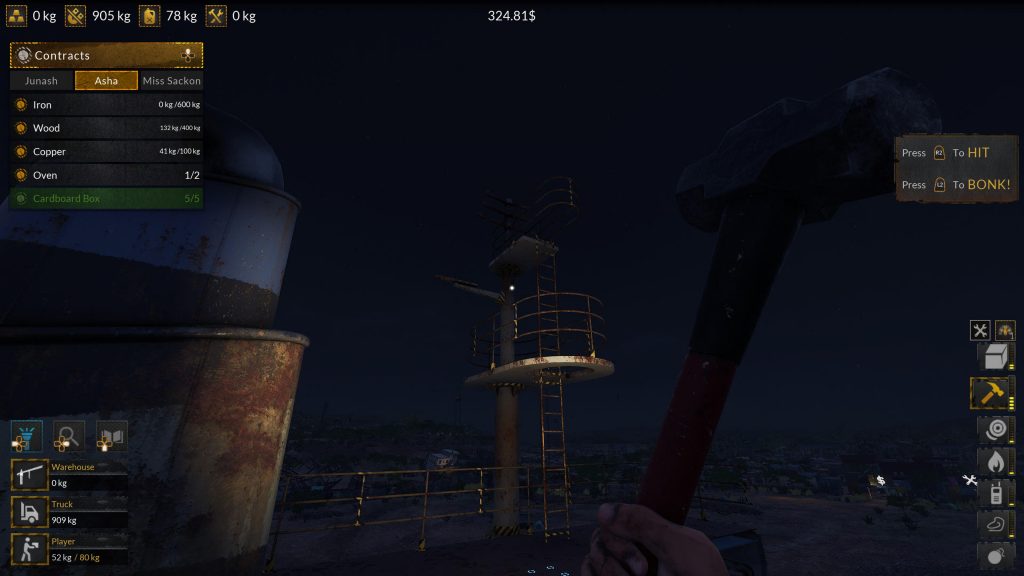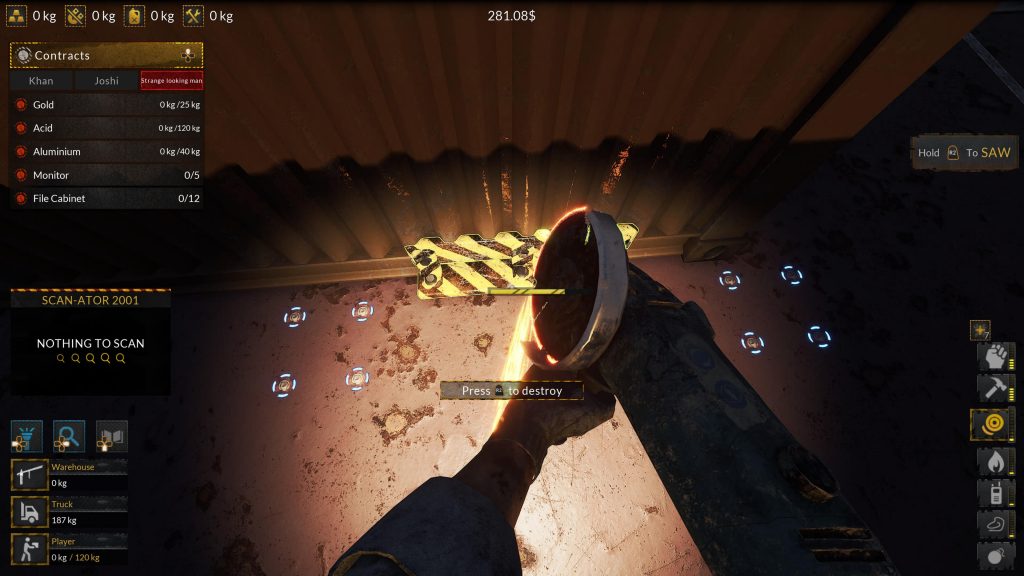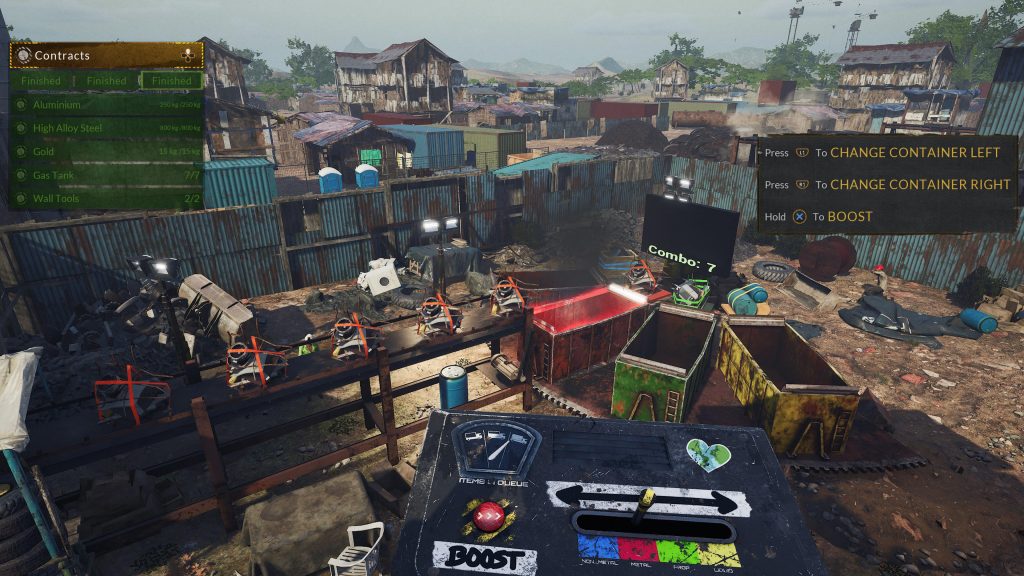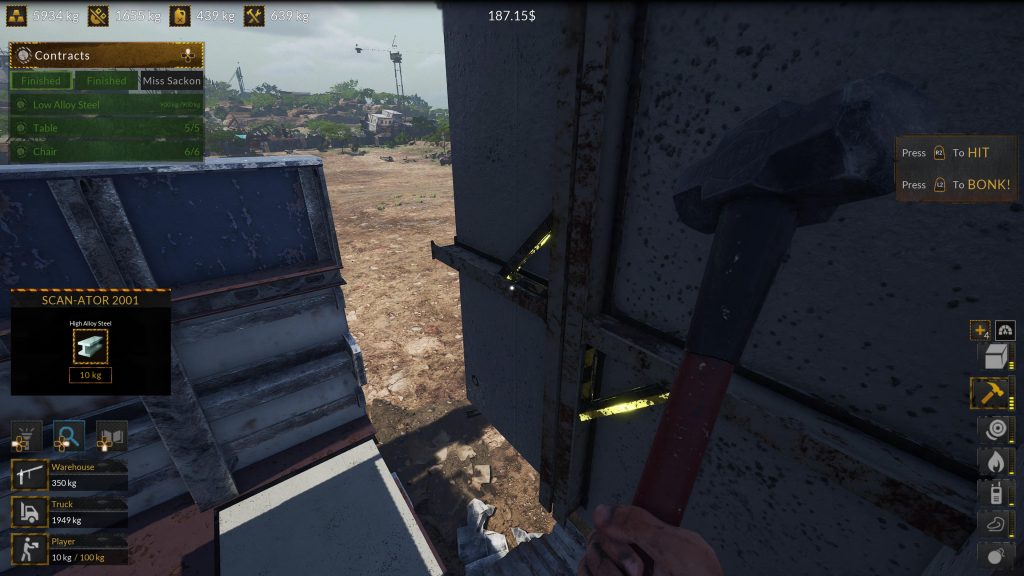There’s a danger with job simulators where they could venture too close into feeling like work. Some manage to avoid it with simplified mechanics, an interesting toolset or bizarre narratives. Ship Graveyard Simulator 2 is certainly playing it straight. Whilst that does lead to a methodical time, the dismantling of a vessel can become a considerable slog. Games Incubator and Hypnotic Ants have done a decent job representing the toil but it’s slow going.
 The process begins easily enough with a laptop providing your avenue to purchase wrecks. They’re cheap and ultimately pay for themselves through salvageable materials and contracts. These contracts require you to salvage specific materials for a number of different benefactors. They’re easy enough to accomplish but a ship’s layout can make things a little tricky.
The process begins easily enough with a laptop providing your avenue to purchase wrecks. They’re cheap and ultimately pay for themselves through salvageable materials and contracts. These contracts require you to salvage specific materials for a number of different benefactors. They’re easy enough to accomplish but a ship’s layout can make things a little tricky.
The tools at your disposal are available immediately. Your sledgehammer looses up bolts and panels which can then be knocked free. It’s the task I’ve spent the most time with and, even with upgrades, the amount of panels make things very time consuming. There are shortcuts you can take. For example, going to a lower floor and knocking that through can make the rest tumble. Setting them all scattering is a satisfying visual but you’ve still got to clean up after yourself.
This comes with its own dangers. There are caches that require a crane to lift. They usually house the most valuable materials so they’re worth recovering. Getting overzealous and taking the floor out beneath it will destroy it. Whilst it is tempting to cut to the chase, there’s still a methodical approach required to take a shit apart.
 The other tools like the saw and torch are used more sparingly. They tend to free up heavy machinery like ship engines and split the hull. The crane requires a clear line of sight to lift a load. It can be interesting trying to figure out a route to make that happen. Typically, I’m surveying the roof above and deciding if removing it will result in collateral damage. At times, the thought process is nice but speeding things up becomes an incremental experience.
The other tools like the saw and torch are used more sparingly. They tend to free up heavy machinery like ship engines and split the hull. The crane requires a clear line of sight to lift a load. It can be interesting trying to figure out a route to make that happen. Typically, I’m surveying the roof above and deciding if removing it will result in collateral damage. At times, the thought process is nice but speeding things up becomes an incremental experience.
It’s a repetitious game that can feel too close to actual work. Clearing the loose materials is done by hand. Whilst upgrading your gloves and crates allows more more stuff to be picked up, hands become full within seconds. You can place skips on the ship itself but my main receptacle tends to be the flatbed of the truck. Even with improved abilities, cheaper vessels can still take serious time to clear. Contract requirements will often see you getting most of the way through the job.
All this acquired scrap has to go somewhere. Your truck can be driven to a recycling plant where materials are sorted. This can involve a mini-game where all the colour-coded loot needs to be placed into the right bins. It’s a simple process and you can earn more money for successful combos. Alternatively, you can opt to have the process handled automatically for a small penalty. I don’t find that hinders my progress much and the tasks take long enough as it is.
There are other things to consider. Some ships have active power supplies that need to be disconnected or gas mains that need to be closed off before continuing. These hazards offer a rare surprise that can make accessing those controls a puzzle in itself. Bolts can carry a current which means finding the fusebox is a necessity before doing any further work in that area.
 This assortment can then be sold for money or used to upgrade your equipment. Firstly, you buy blueprints to then unlock the opportunity to improve them. This is probably the most expensive part of the process which each tier becoming more costly. I still think the financial incentive from salvage outpaces it. Completing contracts can be quite lucrative.
This assortment can then be sold for money or used to upgrade your equipment. Firstly, you buy blueprints to then unlock the opportunity to improve them. This is probably the most expensive part of the process which each tier becoming more costly. I still think the financial incentive from salvage outpaces it. Completing contracts can be quite lucrative.
I do find traversal can be an issue. I prefer to keep any stairs intact as a means to get from deck to deck. You do have a rope to gain access to higher ground but you need a surface to clamber onto. Anything that’s loose, you’ll just phase through so it pays to know what solid ground can be left to stand on. It can be confusing to see an upper area still standing when there’s very little to support it. Sometimes I would struggle to reach it and would ultimately leave that area unfinished.
There’s 16 vessels in total to pick clean and that does result in a lengthy campaign. Two DLC packs called Steel Giants and Submarines add more to the pile and I will say the spatial differences of an underwater submersible is a decent change of scenery. Old boats can be redone and you don’t have to tackle each one in order. That can be freeing as tackling the more expensive boats do reap some sizeable rewards. It’s a chunky time investment which I don’t quite have the patience for. Visually, it’s predictably drab. Ships are constructed of the same tiles so, whilst they do change in scale, they all look familiar. There is a passage of time as day transitions into night and that can help convey the back-breaking labour that’s been represented. To the games credit, saving happens regularly and you can pick up a job where you left off.
 The shopfronts are all fronted by stationary, if helpful vendors that are voiced. The few lines they speak are done well. There’s also a light ambient soundtrack that helps sell the coastal location. There’s a hint of civilisation off in the distance but your work focuses entirely on the shore. Launching cargo into the back of the truck has a satisfying cash register noise that denotes when you’ve hit your target. Little touches like that are nice, even if the game looks fairly bland.
The shopfronts are all fronted by stationary, if helpful vendors that are voiced. The few lines they speak are done well. There’s also a light ambient soundtrack that helps sell the coastal location. There’s a hint of civilisation off in the distance but your work focuses entirely on the shore. Launching cargo into the back of the truck has a satisfying cash register noise that denotes when you’ve hit your target. Little touches like that are nice, even if the game looks fairly bland.
As a premise, Ship Graveyard Simulator 2 presents a methodical dismantling of ships quite well. Jobs can take hours as the layers of each deck are slowly stripped away. Unfortunately, the loop doesn’t really change or quicken over time. Whilst upgrades can bring incremental improvements, the more expensive vessels demand more attention. It can make the pacing feel glacial and certainly tried my patience.
+ Hazards offer interesting challenges to overcome.
+ Saves regularly, allowing jobs to be resumed.
+ Plenty of ships to dismantle.
- Is a very manual, repetitive process.
- Very bland presentation.
- Feels a little too much like work.

